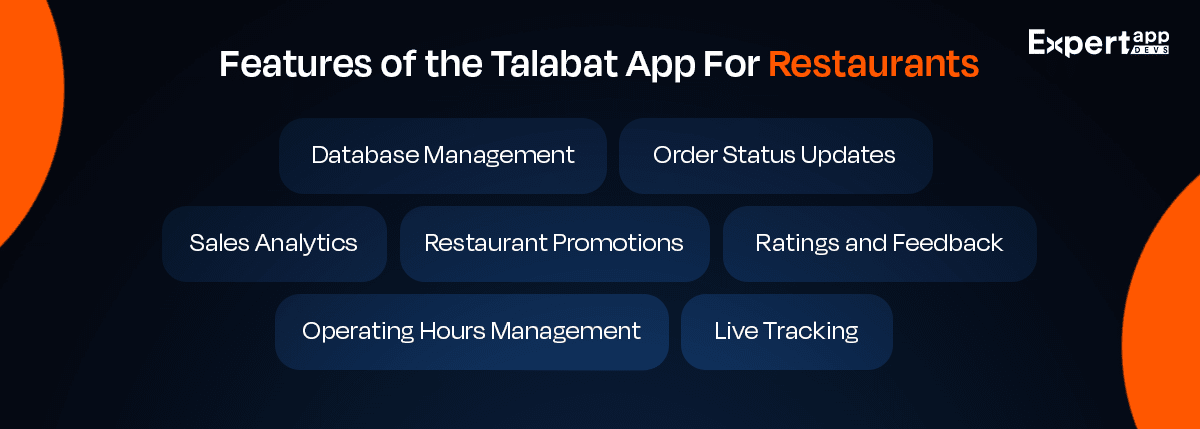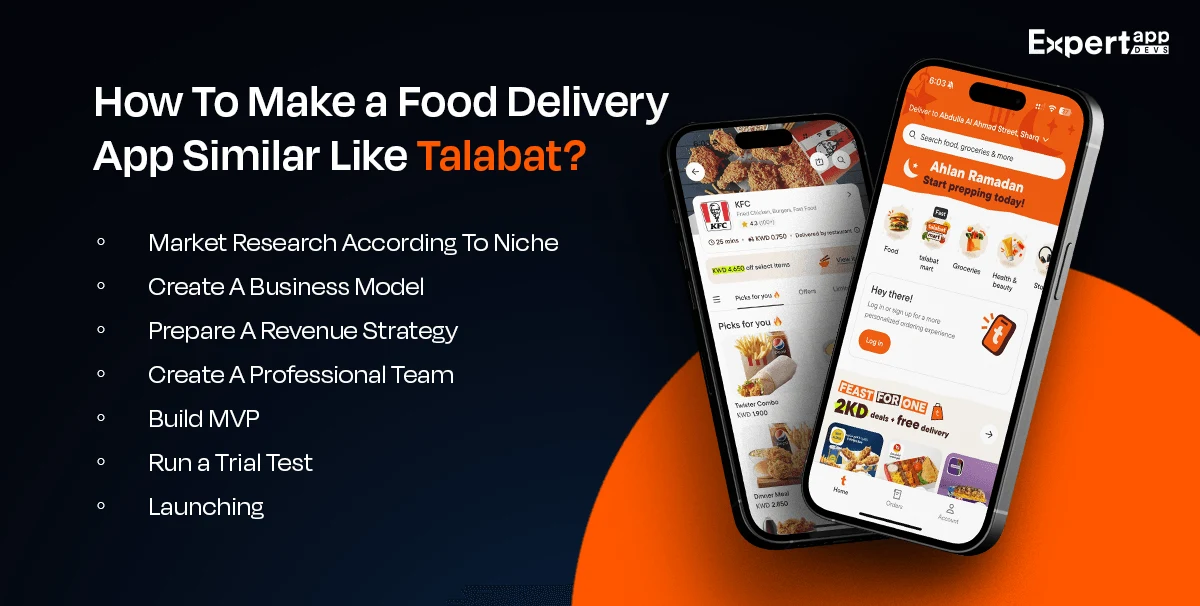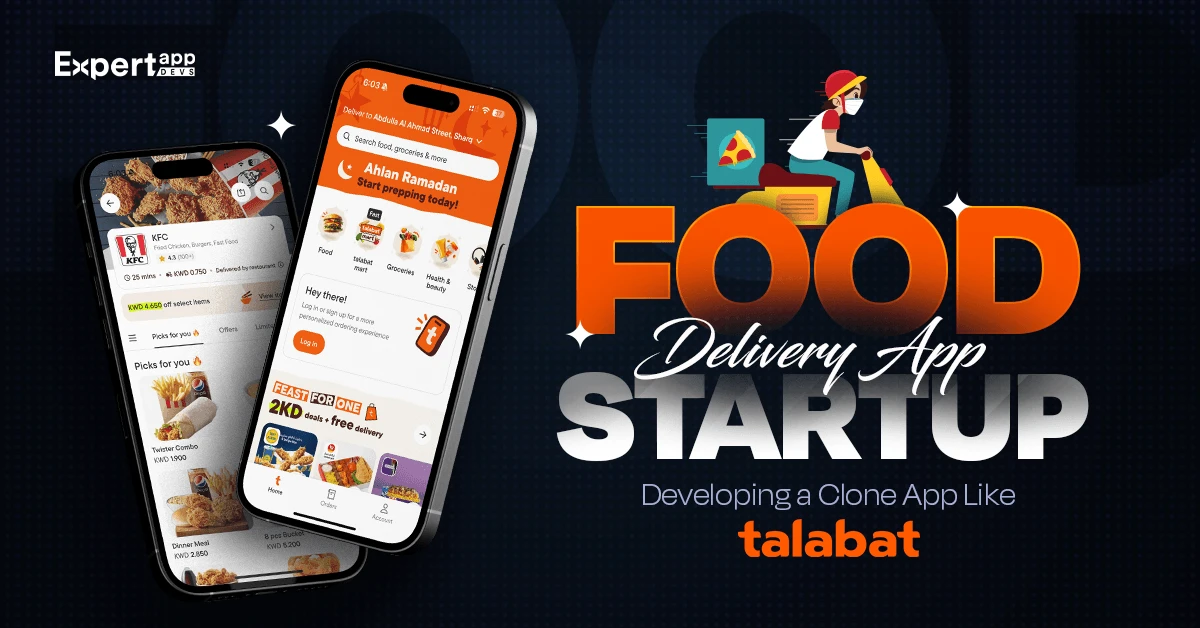Talabat Clone App Development: Scale Your Food Delivery Startup
With the growth of technology, today there is an app for everything to make our day-to-day things easier and more convenient. The food industry is no exception. People are crazily using online food delivery apps. This has actually proven to be one of the best innovations for foodie people as well as the ones with hectic schedules who don't have time to cook meals. Research says that the food delivery market is expected to reach up to $90.3 billion by 2030(globenewswire).
And still, there is no sign of stopping. A revenue report by Statista says that China generated over $450 billion in revenue in 2024. Hence if you are looking to step into the food industry or looking to invest in an online food delivery app, it could be a beneficial decision.
Talabat app sets a good example and has a strong market presence in the Middle East due to its on-demand food delivery service. If you want to know how to develop a Talabat clone app, then read this article to understand from start to end, the important features needed, technical considerations, and all other things.
Before creating a Talabat clone app development, first understand why you should create a food delivery app.
Why Create A Food Delivery App Like Talabat?
If you are in Dubai, Talabat is the #1 food delivery app. If you are in India, Zomato and Swiggy are the most loved food delivery apps. If you are in the UK, Deliveroo is the most revenue-generating food delivery app. No matter where you are located, food delivery is a bustling business and every business needs a food delivery app to serve their customer with convenience. Below are some of the reasons why you should make a food delivery app.

#1. High Market Demand
You can't deny the fact that food delivery apps are in top demand because more and more Genz and millennials are ordering their favorite food from food delivery apps. Obviously, who doesn’t love ordering their favorite food from the comfort of home with just a few taps?
#2. Revenue Opportunities
Food delivery apps are blindly a profitable choice because it allow to generate revenue from multiple streams like commissions from restaurants, delivery fees, premium subscriptions, offers, and much more. You can also earn by using advertising apps and promotions to earn the maximum profit.
#3. Scalable Business Model
The food delivery business has no restrictions. If everything is going well, you can expand your business from local to multiple cities and globally too. This needs proper strategy planning and suitable partnerships.
#4. Support for Local Businesses
This also helps local food businesses and restaurants to create their presence online by registering on the food delivery app. Hence this provides a good opportunity and support to small eateries and startups to get more customers with the help of an app.
#5. Flexible Marketing Opportunities
The app can be used as a great marketing tool to send festival and promotional offers through push notifications. You can also use customer data like orders, food, or restaurants Users love to decide marketing strategies based on that. This helps to engage with users and drive more sales.
The Food App Ideas and its Features are the basic backbone of the app that impacts the success of your food delivery business. To understand better, let's understand the features for customers, restaurants, and app owners before making a Talabat clone-like app or talabat clone app development.
Key Features of the Talabat Application
If you are starting with Talabat clone app development, you need to focus on three parts of the app i.e. customers, restaurants, and app owners because each of them will have different features.
Features of the Talabat App For Customers
Customers are the users who are gonna use your app. Apart from aesthetics and look, it's important that the app serves its purpose and has essential features to allow users to log in, sign up, search for orders, and basic operations. Below are the important customer-side features you must add to your app.

#1. Order Tracking
Once users have placed an order for food from a suitable restaurant, the order tracking feature allows them to track the status of their order like order accepted, preparing food, hand-over to the delivery boy, order on the way, and so on. These changes are updated from the restaurant side to notify the customers about the order status.
#2. Real-Image Display
Make sure you add real images and high-quality pictures of the restaurant and its dishes to give a clear idea to users. This also impacts users' browsing experience and attracts users by giving ideas about location, cleanliness, menus, and other things.
#3. Payment Methods
Make sure you add secure payment methods to your food delivery app. Provide multiple options such as credit/debit cards, digital wallets, net banking, and cash on delivery (COD) so that users can pay via whatever is convenient for them.
#4. Customer Support
Customer support is an important feature of any app. No matter how perfectly you make an app, there are possibilities to occur some technical errors as well as human side errors. Make sure you integrate an AI chatbot for 24*7 assistance to quickly solve users' issues.
#5. Deals and Offers
Provide personalized discounts to new users by giving discounts or rewards on specific restaurants and locations. This motivates users to order food frequently.
#6. Search and Filters
Add advanced search functionality in the app with filters like cuisine, location, price, ratings, dietary preferences, veg/non-veg, food type, and more.
#7. Favorites and Reorders
This section will help users to save their favorite restaurants or meals for quick reordering in the future without wasting time searching.
#8. Order History
Order history shows a list of orders by date, month, location, restaurant, etc…
#9. Multilingual Support
Even if you don't operate in multiple cities, always add a language option to reach a broader audience.
#10. Push Notifications
This includes all types of notifications to keep updated users about orders, upcoming offers, new restaurant additions, and other recommendations based on your order history.
Features of the Talabat App For Restaurants
You need to have a separate database for restaurants with the following functionality!

#1. Database Management
Restaurants and delivery partners will register themselves on your food delivery app hence make sure to have a proper database to manage menu items, pricing, and availability easily.
#2. Order Status Updates
This feature allows both customers and restaurants to receive and update orders with live notifications.
#3. Live Tracking
Restaurants can track delivery partner locations for better coordination.
#4. Sales Analytics
Restaurant owners can check insights about their sales trends, most popular dishes, and peak order times.
#5. Restaurant Promotions
Add a promotion campaign option in the app to allow restaurants to highlight and send special offers to their customers.
#6. Operating Hours Management
Restaurants can set and update their working hours like opening and closing hours and working days.
#7. Ratings and Feedback
This feature allows restaurants to view and respond to customer reviews to improve the service accordingly.
Features of the Talabat Application For App Owners (Admin Panel)
You are the app owner building this Talabat clone app. The below features are essential to maintaining good performance and running a successful food delivery app.

#1. Analytics Dashboard
It shows complete insights and combined data on app performance, user engagement, financial metrics, and other information.
#2. User and Partner Management
This is for control access. You can approve new registrations, and manage profiles for customers, restaurants, and delivery persons.
#3. Map View for Locations
With the help of map view, you can monitor live delivery progress and restaurant locations.
#4. App Settings
It allows you to configure app features like notifications, payment gateways, and language preferences.
#5. Delivery Partner Management
Assign, track, and manage delivery personnel.
#6. Commission and Revenue Management
You can set and track commissions, subscription fees, and other financial aspects.
#7. Dispute Resolution
This feature is useful in handling refunds, or issues raised by customers, restaurants, or delivery persons.
#8. Fraud Detection and Security
This is a security feature that allows you to monitor unusual activities, secure data, and prevent fraud.
Some Important Technical Considerations You Must Keep In Mind
Once you have decided on app features for users, admin, and restaurants, the next step in Talabat clone app development is technological considerations.
#1. Platform Selection- Android Or iOS?
Research your user base, whether you focus on Android users or iOS. Android apps are used globally and iOS apps are for premium markets. So if your budget allows, making cross-platform apps can be a good option.
#2. Technologies List According To App Type
Once you have selected the app platform, decide the back-end and front-end technologies it will require.
For iOS native apps choose Swift. For Android native Kotlin and for cross-platform Flutter is a good option. On the other hand, if you are making a cross-platform app, then select Flutter and react native.
#3. Advanced Features Addons
The food delivery market is already competitive, hence make sure you add advanced features by using AI recommendation and automation to make your app unique from other basic food delivery apps.
#4. AI Chatbots
AI chatbots help to provide assistance 24/7 without human involvement. This helps to provide order tracking, refunds, restaurant recommendations, and more.
#5. AI-Powered Analytics
Digging deep into your user data can help you understand your user in a more better way. Use AI-powered analytics to understand user choices, peak hours, and other user behavior to modify the app in the future.
#6. Route Optimization
Customers love fast delivery. Work on route optimization by using AI and real-time traffic data. This helps to assist a delivery person with the fastest route to deliver the food fresh and hot while saving their fuel costs.
How To Make A Food Delivery App Similar Like Talabat?

#1. Market Research According To Niche
Before jumping directly into Talabat clone app development, you must research completely about the food industry, market leaders, and other competitor apps. If you are focusing on a specific niche like healthy diet food, home-made foods, or any other niche, then research its demand location-wise.
#2. Create A Business Model
After all, your prime goal is to make money from the app so create a well-researched business model. Define how your app will generate revenue via commissions, subscriptions, or partnerships. Consider the necessary marketing strategies you will need, how much time it will take to monetize, maintain, and other factors.
#3. Prepare A Revenue Strategy
To generate a good income, you need a good revenue strategy. You can earn through the app by following models.
- Commission-based model – Charge a percentage on every order.
- Subscription plans – Offer subscription plans to restaurants.
- Delivery and service fees – Charge users based on distance and order size.
- Advertisements and promotions – Allow restaurants to feature ads or sponsored listings.
#4. Create A Professional Team
A skilled team of developers, designers, QA testers, and other professionals is a must for Talabat clone app development. Based on the technologies you choose, hire experts specializing in specific tech stacks.
#5. Build MVP
Never completely invest in your app without MVP testing. Building MVP is the best choice to test your basic version with users to learn about the demand and user behavior.
#6. Run a Trial Test
To be double sure, run a trial testing of your app with a small portion of the audience. Use beta testing to analyze how real users interact with the app. Based on the user feedback, you can improve your app more better.
#7. Launching
Finally, after building MVP and running a trial test, you can release your app on the App Store or Google Play Store. Keep monitoring the app and look after regular maintenance and updates.
Cost of Building a Food Delivery App
You should accept that a food delivery app is going to need lakhs of rupees or dollars if you hire developers from outside countries but it's definitely a profitable business that gives assured returns. The cost of building a clone app like Talabat depends on many factors: the size of the app, the location of the development team, features, tech stacks, platforms chosen, resources, time, efforts, and many more.
To give you a rough talabat clone app development idea, the cost minimum range starts between $15,000 to $30,000+. Though the price can increase according to the functionality you add up, the development team location, development phases, and other integrations.
Challenges and How to Overcome Them
Making a food delivery app like Talabat is not as easy as it looks. Every app development project comes with various challenges. Below are some challenges that you might face while food delivery app development.
#1. Managing Restaurant Partnerships And Delivery Logistics
Coordinating with multiple delivery partners, and restaurants can be complex because you are responsible for the entire delivery process. If the driver takes a long route or delayed delivery, this can impact the user experience. Hence it's important to set a clear contract and set transparent commissions to have proper sync between logistics and the restaurant department.
#2. Handling Competition In A Saturated Market
There are so many food delivery apps right now in the market which means more tougher competition. Users have many choices, think why should they choose your app? The key is providing unique features and better service than your competitors. You can add AI- recommendations to help users choose the food quickly, offer discounts to new users, provide fast deliveries, reliable subscription models with premium benefits, and more.
#3. Ensuring App Security And Data Privacy
Food delivery apps need payment details from users who pay online and use offers and referral codes. You must follow end-to-end encryption, two-factor authentication, and other security protocols to ensure your users feel safe while using the app.
#4. Addressing Scalability For Future Growth
You would have made an app considering the present situation and market demand but what if you got good luck and start gaining thousands of users daily? If your app is not scalable, the app can get slow and frustrate users.
The solution is to use cloud-based solutions, microservices, and scalable back-end technologies.
Food Delivery Clone Marketing and Launch Strategies
After Talabat clone app development, you need strong marketing strategies to attract users.
#1. Pre-Launch Buzz
Pre-launch buzz means creating hype before you launch the app. Create curiosity in users by using social media campaigns, releasing teaser ads, or hire an influencer who can do an ad on your food delivery app telling about the benefits and good points.
#2. Post-Launch User Acquisition
Once your app is live, it’s time to bring users towards it. Offers discounts like 50% off on first 5 orders, free deliveries, or referral bonuses to existing users for joining other users.
#3. Retention Strategies
Retention is most important because this is a long-term partnership. Just getting more downloads is not enough, people staying and enjoying your app is crucial for long-lasting success. Organize loyalty programs, and offer free deliveries and free gifts to loyal users to motivate them to keep using the app.
Conclusion
Despite the well-known food delivery app like Talabat is a technology-driven venture, solving real customer needs is the most important thing. From market research and MVP development to smart marketing and scaling, every step matters. If you are an aspiring entrepreneur, then this is the best time to start! Be small, be flexible, and be strategic in your development.
Are you ready to turn your idea into reality? Reach out to Expert App Devs to get your cost estimation for the app idea. Being an industry experience of 13 years in the mobile app market, we follow a strategic like Talabat clone app development along with proper planning and proof of concept to develop a high-quality app in this rapidly growing industry.
Frequently Asked Questions
#1. How Much Time Does It Take To Develop A Talabat Clone App?
Creating a Talabat clone app can take a few months to years depending on the team size, technology use, expertise, features, complexity, and other app requirements. If you want to know the accurate cost, schedule a free consultation with us, and we will give you a clear idea.
#2. Why is MVP Important Before I Launch The App?
MVP is most important especially if you are new to the industry and don't have an idea about the audience, and their preferences. It helps you to test the app features and functionalities with real users to decide the scope of growth and whether you should invest in full-scale development.
#3. How Can I Monetize My Food Delivery App?
There are many ways to monetize the app. Below are some useful ways.
Restaurant commissions: You can charge a commission on each order they get from your app.
Delivery charges: Add delivery charges to customers according to distance, and order value.
Pro Tip: Provide free delivery to premium users
Subscription plans: introduce subscription plans with amazing benefits. Like for frequent users, provide free deliveries or extra discounts from restaurants.
In-app advertisements: you can charge restaurants for the featured ads and promotions you do on behalf of them.
Other than this, you can charge from the users during peak hours for fast delivery, etc.
#4. How Much Will App Maintenance And Support Cost?
You can expect 15-20% of your cost can go in maintenance and support. It depends on the severity of updates, bug fixes, hosting, and security enhancements. But if you regularly monitor and maintain your app, you can avoid the expensive maintenance process.
#5. How Does the Talabat Business Model Work?
Talabat’s business model is based on commissions. It is basically a three-tier model that involves restaurants, customers, and delivery partners. This is how the Talabat business model works:
- Restaurants register themselves on the Talabat app, and on each order placed by the customer, the Talabat app earns 15% to 20% commission(it might vary on the order quantity).
- The same goes for customers placing orders on the Talabat app; they pay for delivery charges, which might vary during peak hours.
- Moreover, it also has a paid subscription model for premium users that offers discounts and offers on food. Its premium subscription is called Talabat Plus.
Other than this, the Talabat app also provides other services like grocery and pharmaceutical deliveries to generate more revenue.
 Jignen Pandya
Jignen Pandya




